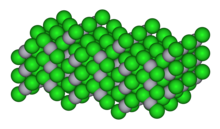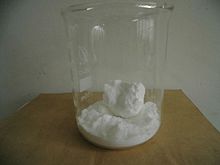Mercury(II) chloride
_chloride-xuvw88timYRe0ntN89YKY61QM8Hsoc)
Mercury(II) chloride
_chloride-xuvw88timYRe0ntN89YKY61QM8Hsoc)
 | |
 | |
 | |
| Names | |
|---|---|
| IUPAC names Mercury(II) chloride Mercury dichloride | |
| Other names Mercuric chloride Corrosive sublimate | |
| Identifiers | |
CAS Number |
|
3D model (JSmol) |
|
| ChemSpider |
|
| ECHA InfoCard | 100.028.454 [39] |
| EC Number | 231-299-8 |
| KEGG |
|
PubChemCID |
|
| RTECS number | OV9100000 |
| UN number | 1624 |
CompTox Dashboard(EPA) |
|
InChI
| |
SMILES
| |
| Properties | |
| HgCl2 | |
| Molar mass | 271.52 g/mol |
| Appearance | colorless or white solid |
| Odor | odorless |
| Density | 5.43 g/cm3 |
| Melting point | 276 °C (529 °F; 549 K) |
| Boiling point | 304 °C (579 °F; 577 K) |
Solubility in water | 3.6 g/100 mL (0 °C) 7.4 g/100 mL (20 °C) 48 g/100 mL (100 °C) |
| Solubility | 4 g/100 mL (ether) soluble in alcohol, acetone, ethyl acetate slightly soluble in benzene, CS2, pyridine |
| Acidity (pKa) | 3.2 (0.2M solution) |
Magnetic susceptibility (χ) | −82.0·10−6cm3/mol |
| 1.859 | |
| Structure | |
| orthogonal | |
Coordination geometry | linear |
Molecular shape | linear |
Dipole moment | zero |
| Thermochemistry | |
Std molar
entropy(S | 144 J·mol−1·K−1[1] |
Std enthalpy of
formation(ΔfH⦵298) | −230 kJ·mol−1[1] |
| Pharmacology | |
ATC code | D08AK03 (WHO [43]) |
| Hazards | |
| Safety data sheet | ICSC 0979 [44] |
EU classification (DSD)(outdated) | |
| R-phrases(outdated) | R28, R34, R48/24/25, R50/53 |
| S-phrases(outdated) | (S1/2), S36/37/39, S45, S60, S61 |
| NFPA 704 |  0 4 1 |
| Flash point | Non-flammable |
| Related compounds | |
Other anions | Mercury(II) fluoride Mercury(II) bromide Mercury(II) iodide |
Other cations | Zinc chloride Cadmium chloride Mercury(I) chloride |
Except where otherwise noted, data are given for materials in their standard state (at 25 °C [77 °F], 100 kPa). | |
| Infobox references | |
Mercury(II) chloride or mercuric chloride (historically "corrosive sublimate")[2] is the chemical compound of mercury and chlorine with the formula HgCl2. It is white crystalline solid and is a laboratory reagent and a molecular compound that is very toxic to humans. Once used as a treatment for syphilis, it is no longer used for medicinal purposes because of mercury toxicity and the availability of superior treatments.
 | |
 | |
 | |
| Names | |
|---|---|
| IUPAC names Mercury(II) chloride Mercury dichloride | |
| Other names Mercuric chloride Corrosive sublimate | |
| Identifiers | |
CAS Number |
|
3D model (JSmol) |
|
| ChemSpider |
|
| ECHA InfoCard | 100.028.454 [39] |
| EC Number | 231-299-8 |
| KEGG |
|
PubChemCID |
|
| RTECS number | OV9100000 |
| UN number | 1624 |
CompTox Dashboard(EPA) |
|
InChI
| |
SMILES
| |
| Properties | |
| HgCl2 | |
| Molar mass | 271.52 g/mol |
| Appearance | colorless or white solid |
| Odor | odorless |
| Density | 5.43 g/cm3 |
| Melting point | 276 °C (529 °F; 549 K) |
| Boiling point | 304 °C (579 °F; 577 K) |
Solubility in water | 3.6 g/100 mL (0 °C) 7.4 g/100 mL (20 °C) 48 g/100 mL (100 °C) |
| Solubility | 4 g/100 mL (ether) soluble in alcohol, acetone, ethyl acetate slightly soluble in benzene, CS2, pyridine |
| Acidity (pKa) | 3.2 (0.2M solution) |
Magnetic susceptibility (χ) | −82.0·10−6cm3/mol |
| 1.859 | |
| Structure | |
| orthogonal | |
Coordination geometry | linear |
Molecular shape | linear |
Dipole moment | zero |
| Thermochemistry | |
Std molar
entropy(S | 144 J·mol−1·K−1[1] |
Std enthalpy of
formation(ΔfH⦵298) | −230 kJ·mol−1[1] |
| Pharmacology | |
ATC code | D08AK03 (WHO [43]) |
| Hazards | |
| Safety data sheet | ICSC 0979 [44] |
EU classification (DSD)(outdated) | |
| R-phrases(outdated) | R28, R34, R48/24/25, R50/53 |
| S-phrases(outdated) | (S1/2), S36/37/39, S45, S60, S61 |
| NFPA 704 |  0 4 1 |
| Flash point | Non-flammable |
| Related compounds | |
Other anions | Mercury(II) fluoride Mercury(II) bromide Mercury(II) iodide |
Other cations | Zinc chloride Cadmium chloride Mercury(I) chloride |
Except where otherwise noted, data are given for materials in their standard state (at 25 °C [77 °F], 100 kPa). | |
| Infobox references | |
Production and basic properties
Mercuric chloride exists not as a salt composed of discrete ions, but rather is composed of linear triatomic molecules, hence its tendency to sublime. In the crystal, each mercury atom is bonded to two close chloride ligands with Hg—Cl distance of 2.38 Å; six more chlorides are more distant at 3.38 Å.[3]
- HgNO3
- 2 HCl → HgCl
- H
Heating a mixture of solid mercury(II) sulfate and sodium chloride also affords volatile HgCl2, which sublimes and condenses in the form of small rhombic crystals.[2]
Its solubility increases from 6% at 20 °C (68 °F) to 36% in 100 °C (212 °F). In the presence of chloride ions, it dissolves to give the tetrahedral coordination complex [HgCl4]2−.
Applications
The main application of mercuric chloride is as a catalyst for the conversion of acetylene to vinyl chloride, the precursor to polyvinylchloride:
- C2H2
- HCl → CH
For this application, the mercuric chloride is supported on carbon in concentrations of about 5 weight percent. This technology has been eclipsed by the thermal cracking of 1,2-dichloroethane. Other significant applications of mercuric chloride include its use as a depolarizer in batteries and as a reagent in organic synthesis and analytical chemistry (see below).[4] It is being used in plant tissue culture for surface sterilisation of explants such as leaf or stem nodes.
As a chemical reagent
Mercuric chloride is occasionally used to form an amalgam with metals, such as aluminium. Upon treatment with an aqueous solution of mercuric chloride, aluminium strips quickly become covered by a thin layer of the amalgam. Normally, aluminium is protected by a thin layer of oxide, thus making it inert. Once amalgamated, aluminium can undergo a variety of reactions. For example, upon removal of the oxide layer, the exposed aluminium will immediately react with water generating Al(OH)3 and hydrogen gas. Halocarbons react with amalgamated aluminium in the Barbier reaction. These alkylaluminium compounds are nucleophilic and can be used in a similar fashion to the Grignard reagent. Amalgamated aluminium is also used as a reducing agent in organic synthesis. Zinc is also commonly amalgamated using mercuric chloride.
Mercuric chloride is used to remove dithiane groups attached to a carbonyl in an umpolung reaction. This reaction exploits the high affinity of Hg2+ for anionic sulfur ligands.
Mercuric chloride may be used as a stabilising agent for chemicals and analytical samples. Care must be taken to ensure that detected mercuric chloride does not eclipse the signals of other components in the sample, such as is possible in gas chromatography.[5]
Historical use in photography
Mercury(II) chloride was used as a photographic intensifier to produce positive pictures in the collodion process of the 1800s. When applied to a negative, the mercury(II) chloride whitens and thickens the image, thereby increasing the opacity of the shadows and creating the illusion of a positive image.[6]
Historical use in preservation
For the preservation of anthropological and biological specimens during the late 19th and early 20th centuries, objects were dipped in or were painted with a "mercuric solution". This was done to prevent the specimens' destruction by moths, mites and mold. Objects in drawers were protected by scattering crystalline mercuric chloride over them.[7] It finds minor use in tanning, and wood was preserved by kyanizing (soaking in mercuric chloride).[8] Mercuric chloride was one of the three chemicals used for railroad tie wood treatment between 1830 and 1856 in Europe and the United States. Limited railroad ties were treated in the United States until there were concerns over lumber shortages in the 1890s.[9] The process was generally abandoned because mercuric chloride was water-soluble and not effective for the long term, as well as being highly poisonous. Furthermore, alternative treatment processes, such as copper sulfate, zinc chloride, and ultimately creosote; were found to be less toxic. Limited kyanizing was used for some railroad ties in the 1890s and early 1900s.[10]
Historic use in medicine
Mercuric chloride was used to disinfect wounds by Arab physicians in the Middle Ages.[11] It continued to be used by Arab doctors into the twentieth century, until modern medicine deemed it unsafe for use.
Syphilis was frequently treated with mercuric chloride before the advent of antibiotics. It was inhaled, ingested, injected, and applied topically. Both mercuric-chloride treatment for syphilis and poisoning during the course of treatment were so common that the latter's symptoms were often confused with those of syphilis. This use of "salts of white mercury" is referred to in the English-language folk song "The Unfortunate Rake".[12]
Yaws was treated with mercuric chloride (labeled as Corrosive Sublimate) before the advent of antibiotics. It was applied topically to alleviate ulcerative symptoms. Evidence of this is found in Jack London's book "The Cruise of the Snark" in the chapter entitled The Amateur M.D.
Historic use in crime and accidental poisonings
In volume V of Alexandre Dumas' Celebrated Crimes, he recounts the history of Antoine François Desrues, who killed a noblewoman, Madame de Lamotte, with "corrosive sublimate".[13]
In one highly publicized case in 1920, "mercury bichloride" was reported to have caused the death of 25-year-old American silent-film star Olive Thomas. While vacationing in France and staying at the Hôtel Ritz in Paris, she accidentally (or perhaps intentionally) ingested the compound, which had been prescribed to her husband Jack Pickford in liquid topical form to treat his "chronic syphilis". Thomas died five days later.[14][15]
Mercuric chloride was used by Madge Oberholtzer to commit suicide after she was kidnapped, raped, and tortured by Ku Klux Klan leader D.C. Stephenson. Oberholtzer died from a combination of mercury poisoning and staph infection, the latter caused by Stephenson biting her during the assault.[16]
Toxicity
Mercuric chloride is extremely toxic, both acutely and as a cumulative poison. Its toxicity is due not just to its mercury content but also to its corrosive properties, which can cause serious internal damage, including ulcers to the stomach, mouth, and throat, and corrosive damage to the intestines. Mercuric chloride also tends to accumulate in the kidneys, causing severe corrosive damage which can lead to acute renal failure. However, mercuric chloride, like all inorganic mercury salts, does not cross the blood-brain barrier as readily as organic mercury, although it is known to be a cumulative poison.
Common side effects of acute mercuric chloride poisoning include burning sensations in the mouth and throat, stomach pain, abdominal discomfort, lethargy, vomiting of blood, corrosive bronchitis, severe irritation to the gastrointestinal tract, and kidney failure. Chronic exposure can lead to symptoms more common with mercury poisoning, such as insomnia, delayed reflexes, excessive salivation, bleeding gums, fatigue, tremors, and dental problems.